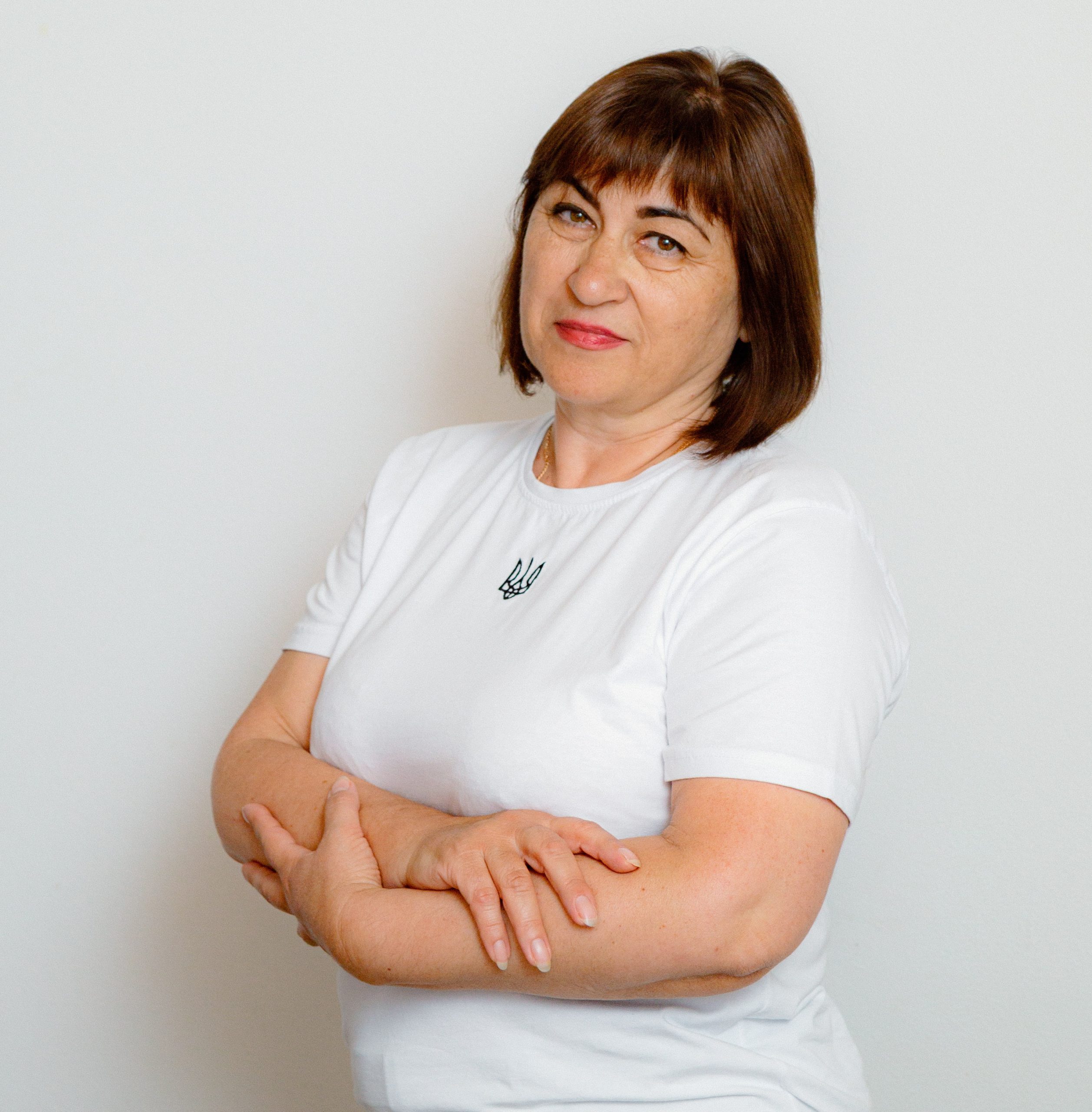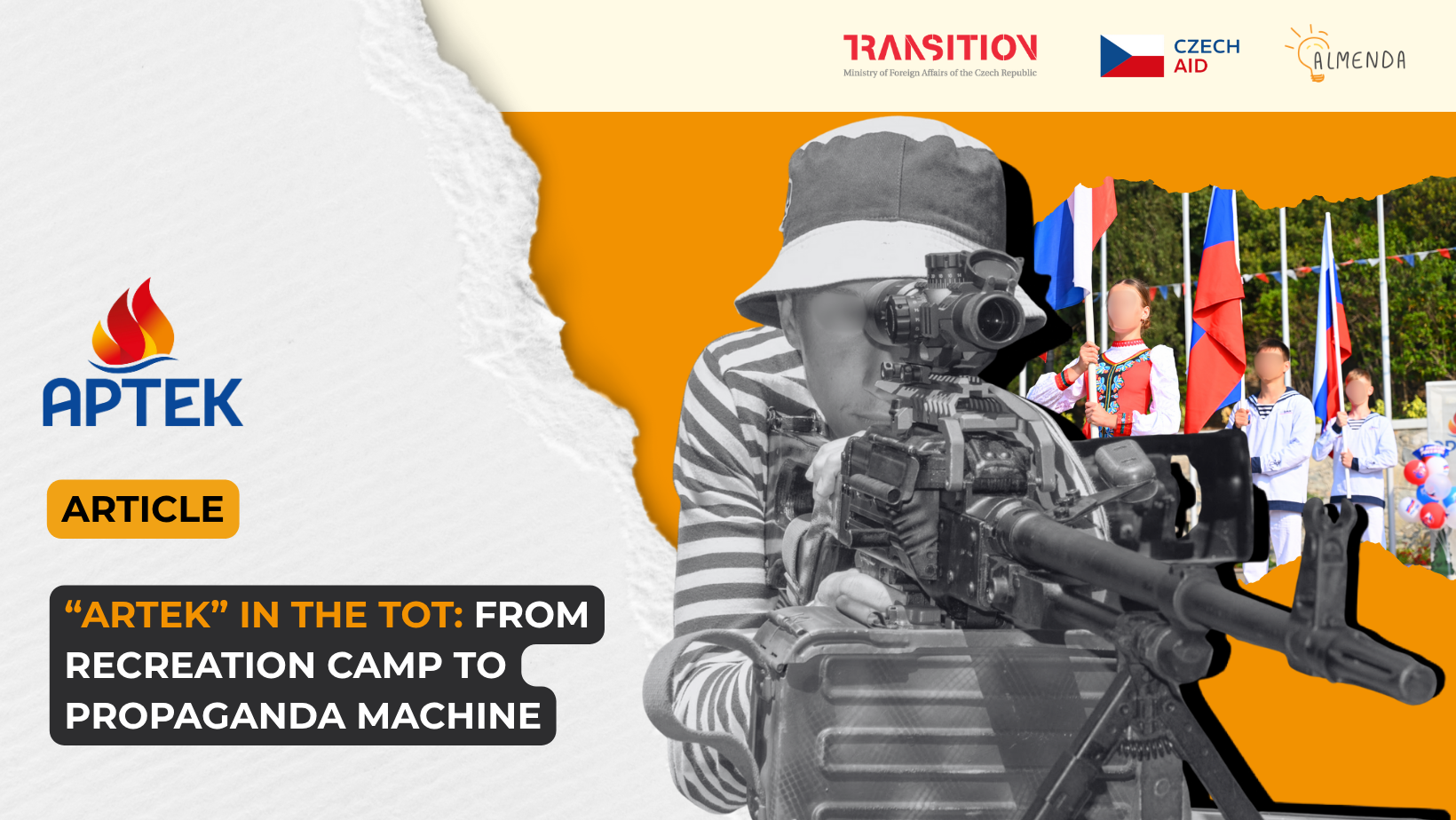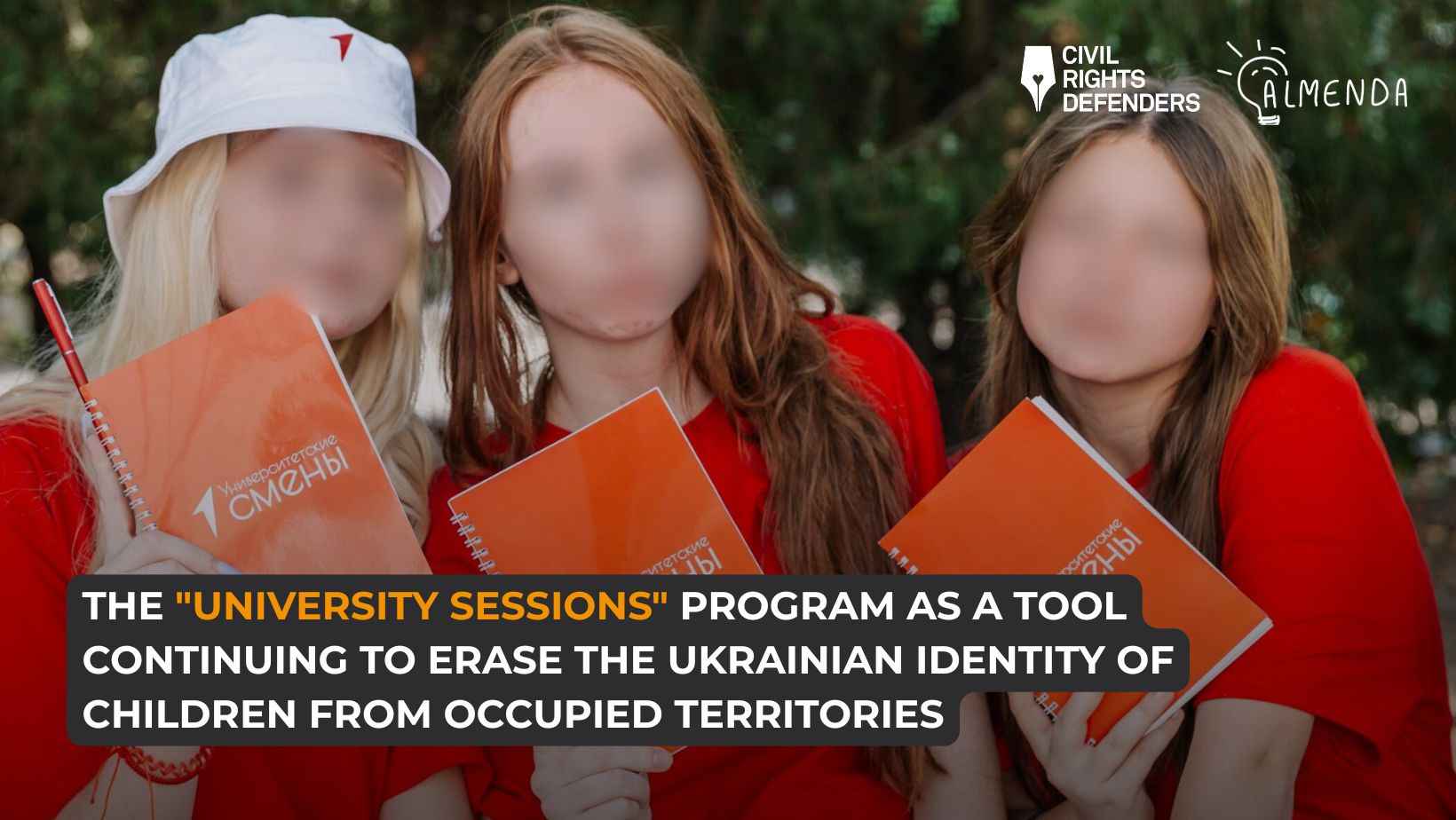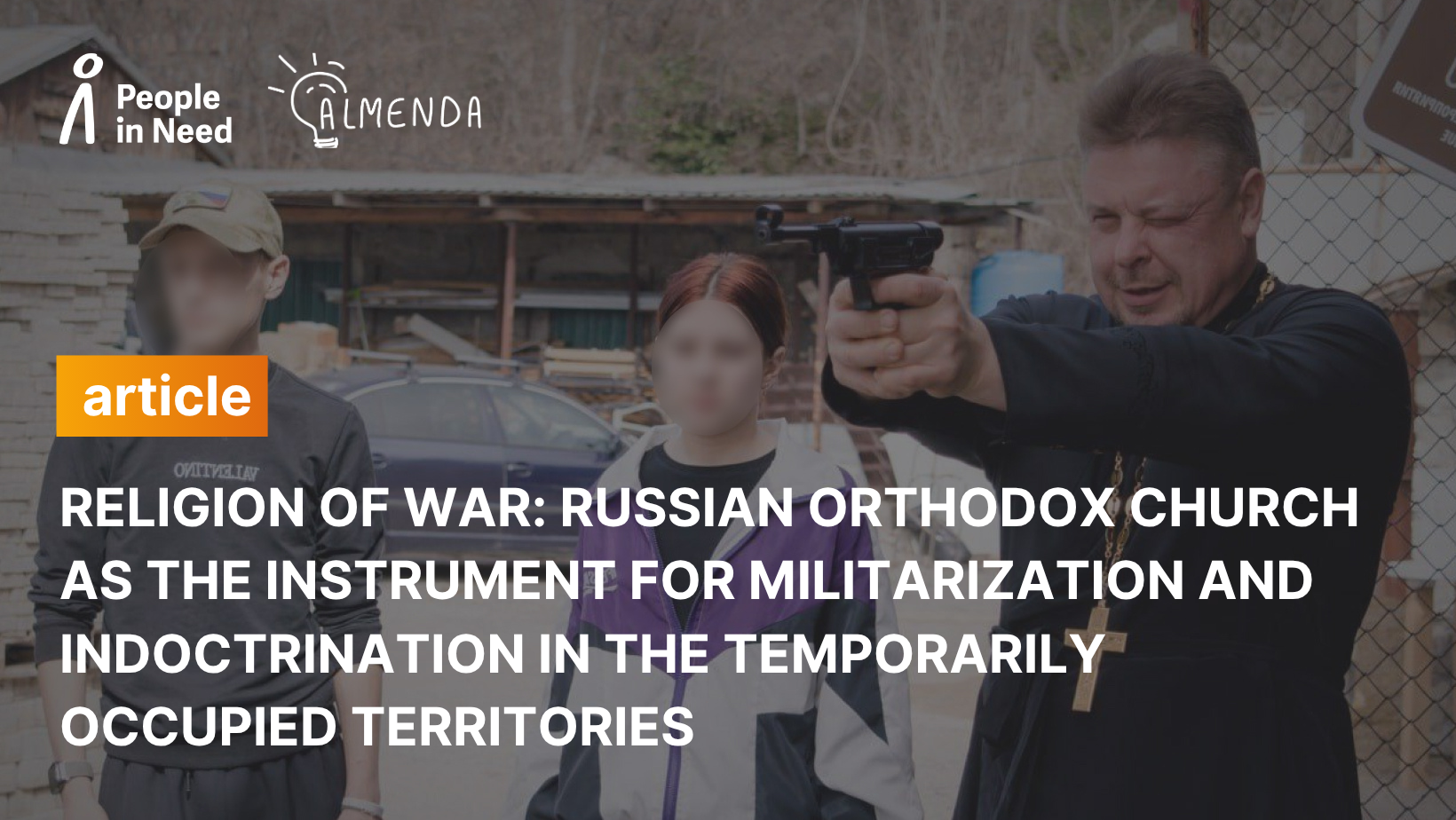

How Russia Influences the Minds of Ukrainian Children from the Temporarily Occupied Territories: The Case of the “University Sessions” Programme
Article for media “24 kanal”




Authors
1
Russia is building a “Russian world” by capturing territories – Abkhazia, North Ossetia, Ukraine, Transnistria. However, it is not just land, first of all it is people. The occupying country is actively trying to turn Ukrainians, Moldovans, Georgians and other representatives of different peoples living in the occupied territories into Russians.
The occupiers pay special attention to children. Even before the beginning of the Russian-Ukrainian war, Russia began to create conditions for replacing the Ukrainian identity of children with a Russian one by conducting various propaganda and educational activities (from the creation of youth Cossack units in Crimea to various competitions). With the beginning of the occupation of Crimea, the pressure on children only increased – everything Ukrainian in Crimea was destroyed, the educational system completely transferred to Russian standards, new form of influence began to implemented (especially militaristic nature, such as the creation of the children’s and youth militaristic organization Yunarmiya). And after full-scale invasion, the so-called “new territories” (partially occupied Zaporizhzhia, Kherson, Donetsk, and Luhansk regions) began to implement the “Crimea scenario” of indoctrination of children – Ukrainian textbooks were destroyed, Russian standards were implemented, the activities of children’s and youth organizations were expanded. In addition, new initiatives were implemented to destroy Ukrainian identity and form a Russian one. One of these areas was the “University sessions”.
So, what is the “University sessions” program?
The “University sessions” program is a short-term transfer of children of high school age (12-17 years old) from the temporarily occupied territories (parts of Kherson, Zaporizhzhia, Donetsk, Luhansk and Kharkiv regions) to higher education institutions of the Russian Federation in order to create conditions for the destruction of children's Ukrainian identity through participation in cultural, educational, propaganda, militaristic and other activities.
The implementation of the “University sessions” by the Russian Federation contradicts international law, such as the Convention on the Rights of the Child, the Geneva Convention relative to the Protection of Civilian Persons, and other documents.
A few months after the beginning of the full-scale invasion, Russia began to transfer children. Since June 2022, the “University sessions” program has covered more than 20 thousand Ukrainian children aged 12 to 17. 81 universities in 47 Russian regions were involved. The “University sessions” program required significant funds, and it is estimated that more than 500 million rubles (over $6 million) were spent only in 2022. The Ministry of Education, the Ministry of Science and Higher Education, the Federal Agency for Youth Affairs (Rosmolodezh), the Russian Movement of Children and Youth “Movement of the First” and many regional ministries, departments, institutions and organizations, including the so-called governing bodies and institutions in the temporarily occupied territories, were involved in the implementation of the “University sessions” program. The implementation of this program was personally overseen by V. Putin and was discussed at the highest levels of the occupying power.
The standard “University sessions” duration is 10 days. The program includes invariant and variable parts, and is divided into 6 mandatory modules: educational, cultural and patriotic, super-professional, sports, excursions, and recreation. A mandatory condition of the “University sessions” program is a patriotic orientation. In addition, according to the terms of the program, Russian higher education institutions work with children, applying psychological influence to them and implementing a program aimed at forming Russian identity and popularizing Russian youth movements.
What is the importance of creating an identity for teenagers?
Firstly, the stated aim of the program is career guidance and the formation of Russian identity.
Identity formation is the most important factor and condition for a teenager’s transition to adulthood. At this age, self-image emerges as the most important thing. This helps to remove the contradiction between the social and the personal. That is why this project is aimed at rethinking their role in a new society that is still unfamiliar to Ukrainian teenagers. Ukrainian teenagers have to become familiar with Russian everyday life in the occupied territories. But at home, they are influenced by the most authoritative people for them – their parents. And this influence can be far from Russian standards. Ten days spent in the “University sessions” without parents, under the close supervision of the “right” teachers, psychologists and counselors, is a very effective move..
Secondly, the components of human identity are cognitive, emotional, and motivational. It is in their interaction that the dynamics of identity development takes place.
Each HEI that accepts children for the “University sessions” develops its own change program, but it should consist of six mandatory modules: educational, cultural and patriotic, super-professional, sports, excursions and recreation.
What is the importance of identity components for the formation of teenagers’ identity?
Comparing yourself to other people is important for teenagers. Peer groups have a very important role for teenagers, especially for the development of identification and the formation of attitudes. They develop the ability to concretize abstract concepts, to reveal their meaning in concrete images and ideas.
The educational block of the project includes 32 hours of lectures on Russian history with mandatory note-taking. Russian professors lecture on German Nazism and draw parallels with “Ukranian Nazism,” which “the SMO soldiers are heroically fighting.”
Meetings with members of the Sirius and Zarnitsa student law enforcement units, self-defense and shooting lessons are just a partial list of the cultural and patriotic activities.
An excursion for children from TOT who participated in the “University sessions” to the Patriot Park, which demonstrates vehicles of all types and branches of the military, military-themed exhibits, and tactical games. There is also an exhibition dedicated to the so-called SMO, in which representatives of trophy weapons and military vehicles, including from the United States and other NATO countries.
Some university representatives define the super-professional block as the main one in implementing specific changes, saying that “by focusing on career guidance, they hope that many children will enter their university after graduation.”
The titles of the sports, recreation, and excursion activities suggest themselves: the Victory Records game, the interactive exhibition in the park “Russia is My History,” the thematic meeting “Being with Russia,” the game “Russian World,” the rally-concert “Your Home is Russia,” and the intellectual game “My Russia is My Country.”
Involvement of children from TOT to participate in the rally-concert “Your Home is Russia!” organized on the Day of Reunification of Donetsk and Luhansk People’s Republics, Zaporizhzhia and Kherson Regions with Russia.
Thus, the programs of the “University sessions” include the behavioral level (readiness for action); cognitive level (perception of the object of identification, including oneself in it); emotional level (feelings towards the object of identification), which leads to the displacement of Ukrainian identity, Russification and indoctrination of children.
Thirdly, in psychology, the concept of “symbol” is used as an image that represents other images, meanings, and relationships. Symbolic policy is implemented through symbols and logos.
How does political symbolism affect the formation of teenagers’ identity?
The “University sessions” immerse Ukrainian teenagers in political symbolism. The use of political symbols is aimed at their emotional perception, at awakening a sense of loyalty to the authorities. Political symbols are used for political communication, and the language of power is realized. Political symbols perform cognitive, educational, communicative, and mobilizing functions and act as a means of identification and ideological influence on Ukrainian teenagers.
Consider how this happens on the example of the “University sessions” that took place at Saratov National Research University
The session began with the raising of flags (Russian, regional, university), i.e., the use of national and state symbols of Russia. Next, Ukrainian children were taken on excursions around Saratov, showing architectural and sculptural symbols (important buildings, architectural complexes, structures that are important in politics). They also used political language (special language constructions used in politics, such as the language of legislation, administrative and legal language, management, communication and negotiation, political education, political propaganda, political rhetoric, slogans, etc.) Thus, after planting the seedlings, which is another manifestation of symbolism (a symbol of the birth of new relationships), Maria Chevtaeva, an employee of the University’s Youth Policy Department, said: “Planting trees is one of the honorable things to do, where love for the Motherland is expressed not in words but in deeds”. Of course, this refers to Russia as the homeland of teenagers who were born and spent their lives in Ukraine and came from the Ukrainian land to Russia for ten days. And this is just one example of the use of political language as a means of political education and political propaganda in the “University Sessions”.
An example of conceptual symbols (groups of words in the political lexicon that have a certain political meaning: the state symbolizes the country, the government, the people) was the meeting of children from Ukraine with the governor of the region, R. V. Busarin, who said: “We are doing everything possible to bring peace to Donbass and Novorossiya. I am sure we will succeed because Russia is a strong country”.
Different groups of symbols are used for influence: visual symbols (color, images symbolizing feelings, combined as national symbols); hearing symbols (hymns, songs, marches); motor symbols (fireworks, parades, receptions, processions, etc.). That’s why Ukrainian children were invited to events where all groups of symbols were used – at the “Your Home is Russia!” holiday in honor of the anniversary of the “reunification of the new regions,” they cut out the coat of arms of the Saratov region at a workshop.
Students of Saratov National Research University and members of the “University sessions” – children from the TOT of Ukraine at a rally-concert dedicated to the “anniversary of the reunification of Donbass and Novorossiya”
Symbolism requires an active attitude to symbolic reality, and university representatives, practically peers, were able to make high school students interested in the uniforms of student teams. And the players of the Saratov Beach Soccer Club even played a game of “giveaways,” as one of the Ukrainian teenagers, Rostyslav Naumov, said: “It was interesting to play, even though we were being played.”
People are also actively used as political symbols. The “University sessions” in Saratov were attended by the governor, the Deputy Minister of Science and Higher Education of the Russian Federation, the coordinator of the regional headquarters of the MYVMESTE project, the chairman of the regional youth policy committee, the head of the regional branch of the all-Russian movement of children and youth “Movement of the First”, a representative of the Russian Union of Writers.


Teleconference for children from the TOT of Ukraine with the Deputy Minister of Science and Higher Education of the Russian Federation – O. Petrova
.
Therefore, the Russian project “University sessions” aims to influence the consciousness of Ukrainian teenagers at the behavioral, cognitive, and emotional levels in order to indoctrinate and destroy Ukrainian identity. And the corresponding symbolic policy is not only a tool but also an indoctrination indicator for Ukrainian teenagers, since the attitude to symbols can be used to judge the views and support of the existing social and political system.
The publication was prepared with the financial support of the Czech organization People in Need, as a part of the SOS Ukraine initiative. The content of the publication does not necessarily match their position.



